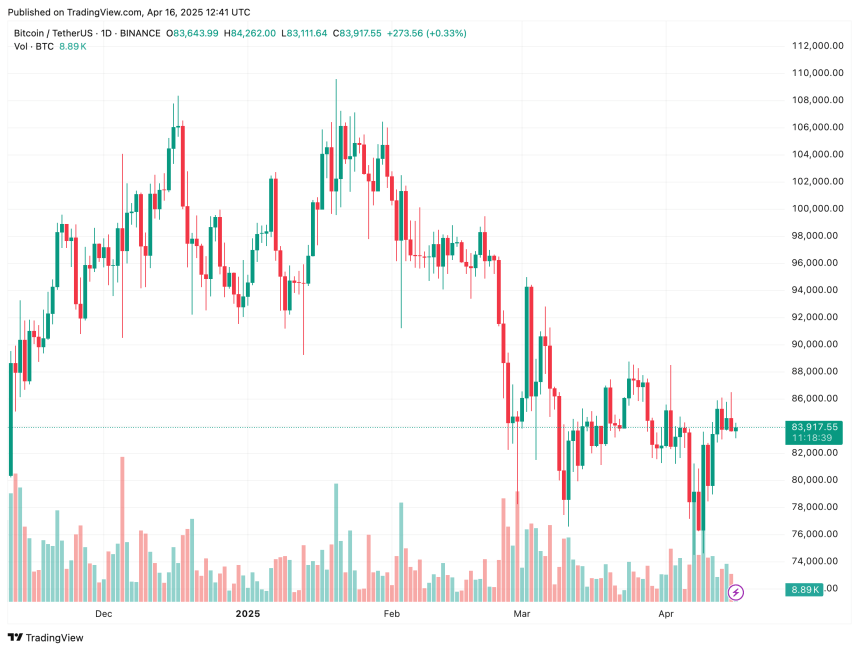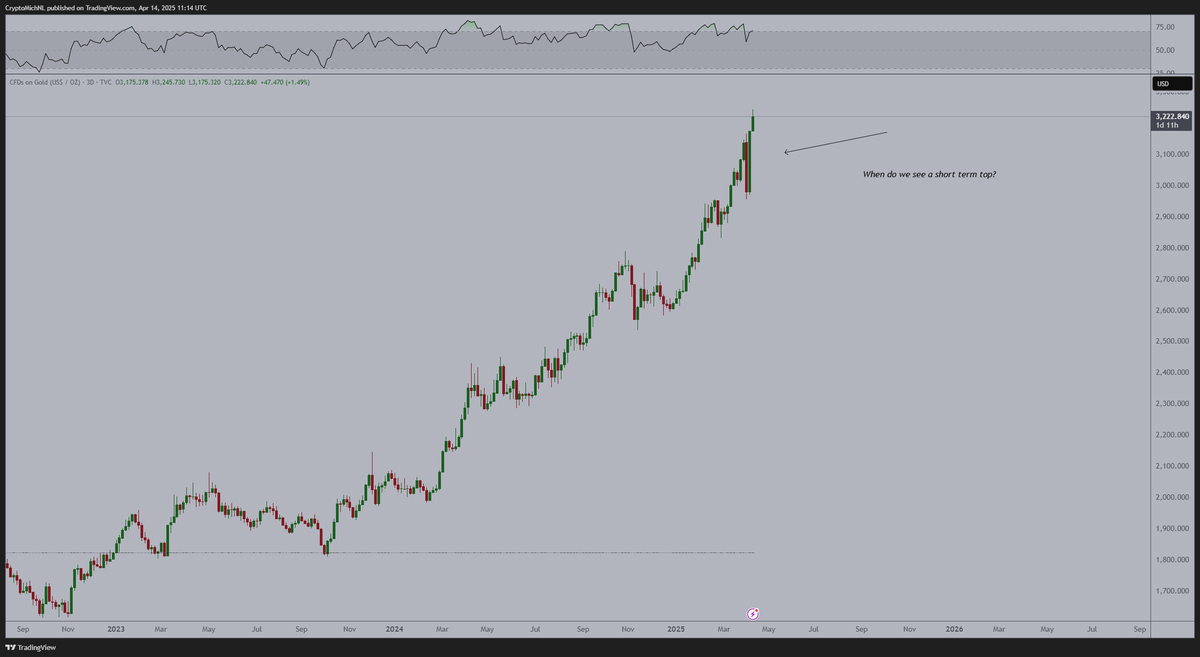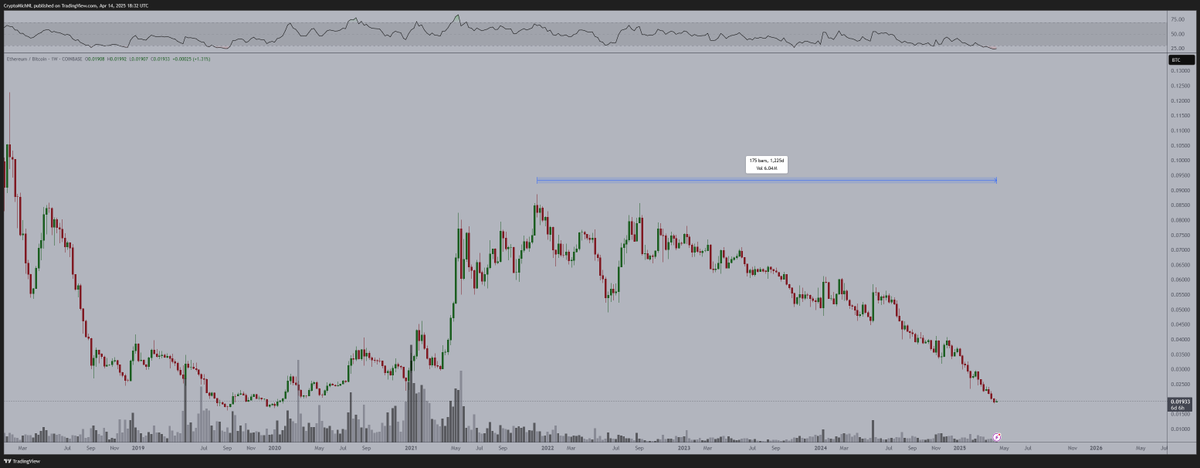Bitcoin
Bitcoin (BTC) Price Posts Worst Q1 in a Decade, Raising Questions About Where the Cycle Stands
Published
1 week agoon
By
admin
Bitcoin just notched its worst first quarter in a decade, falling 11.7% as markets struggled to understand the new administration’s economic agenda.
The performance ranked 12th out of the past 15 first quarters, according to NYDIG Research’s data.
The drawdown invites a familiar question in crypto circles: is the cycle over? The last time bitcoin started the year this poorly was in 2015, during a prolonged slump following the 2013 peak and after the collapse of Mt. Gox, according to NYDIG. Back then, prices recovered modestly over the rest of the year before surging in 2016.

In the first quarter of 2020, amid a market sell-off tied to fears surrounding the COVID-19 pandemic, BTC saw a 9.4% drawdown but then recovered to end the year up over 300%. In other years with negative Q1 returns—like 2014, 2018 and 2022—bitcoin ended the year down sharply, coinciding with the tail ends of previous bull cycles, the research note said.
This time around, the backdrop is murky. Cryptocurrency prices surged after Donald Trump won the U.S. election in November after running a pro-crypto campaign. While under the Trump administration, the sector has been gaining greater regulatory clarity, and the U.S. Securities and Exchange Commission (SEC) backed off a number of lawsuits against crypto firms, it isn’t all bullish.
Trump unveiled his reciprocal tariffs against nearly every country in the world last week, leading to a massive $5.4 trillion U.S. equities market wipeout in just two days. This led to the S&P 500 index’s lowest level in 11 months and the Nasdaq 100’s entry into bear market territory. While bitcoin has outperformed so far, what will happen after Monday’s opening bell is unclear.
Historically, a weak Q1 doesn’t always spell doom for BTC, NYDIG’s data shows. The asset has bounced back in half of the years when it started in the red. The recent macroeconomic backdrop has seen analysts raise recession odds, which could test BTC’s role as a “U.S. isolation hedge.”
Read more: Chart of The Week: Will April Bring Good Luck or Fool’s Hope for Bitcoin?
Source link
You may like


Bitcoin Price Holds Steady, But Futures Sentiment Signals Caution


Panama City Approves Bitcoin And Crypto Payments For Taxes, Fees, And Permits


Crypto Trader Says Solana Competitor Starting To Show Bullish Momentum, Updates Outlook on Bitcoin and Ethereum


weakness signals move toward lower support


Now On Sale For $70,000: The World’s First Factory Ready Open-Source Humanoid Robot


What Next for ETH as Traders Swap $86M into Solana DeFi protocols ?
Bitcoin
Bitcoin Price Holds Steady, But Futures Sentiment Signals Caution
Published
1 hour agoon
April 17, 2025By
admin
Reason to trust

Strict editorial policy that focuses on accuracy, relevance, and impartiality
Created by industry experts and meticulously reviewed
The highest standards in reporting and publishing
Strict editorial policy that focuses on accuracy, relevance, and impartiality
Morbi pretium leo et nisl aliquam mollis. Quisque arcu lorem, ultricies quis pellentesque nec, ullamcorper eu odio.
According to a recent CryptoQuant Quicktake post, while Bitcoin (BTC) has seen a steady rise in price from November 2024 to February 2025, sentiment in the cryptocurrency’s futures market has not shown a corresponding uptick.
Bitcoin Futures Sentiment Index Signals Caution
Bitcoin’s price surged from approximately $74,000 in November 2024 to a peak of $101,000 by early February 2025. However, following US President Donald Trump’s tariff announcements, risk-on assets – including BTC -have experienced a significant pullback.
Related Reading
After hitting a potential local bottom of $74,508 earlier this month on April 6, the apex cryptocurrency has recovered some of its recent losses. The top digital asset is trading in the mid $80,000 range at the time of writing.
Despite this recovery, BTC’s futures sentiment has continued to decline since February. Even as the price holds near local highs, sentiment in the futures market has notably cooled.
CryptoQuant contributor abramchart highlighted this divergence, noting that it could indicate increasing caution or profit-taking behavior despite the ongoing bullish trend. The analyst commented:
This indicates a cooling interest or increased fear in the futures market, possibly due to macroeconomic uncertainty, regulatory concerns, or expected corrections.
A look at the BTC futures sentiment index shows a resistance zone around 0.8 and a support level near 0.2. The index is currently hovering around 0.4, pointing to a predominantly bearish sentiment across futures markets.

Similarly, Bitcoin’s average price has steadily declined from its early 2025 highs. It is now ranging between $70,000 and $80,000, signalling possible market indecision amid heightened tariff tensions.
According to abramchart, if futures sentiment remains low, BTC could face extended price consolidation or even downward pressure in the near term. However, any emerging bullish catalyst could quickly shift the sentiment and renew upward momentum.
Is BTC Close To A Momentum Shift?
Some analysts believe Bitcoin may be nearing a breakout. After consolidating in the mid-$80,000s for several weeks, on-chain metrics suggest BTC may be undervalued at current levels. Indicators such as BTC exchange reserves and the Stablecoin Supply Ratio support this view.
Related Reading
In addition, momentum indicators like Bitcoin’s weekly Relative Strength Index have begun to break out of a long-standing downward trendline – raising hopes for a potential bullish rally back toward $100,000.
However, several risks still remain. The recent appearance of a ‘death cross’ on BTC’s price chart – combined with persistent macroeconomic concerns related to trade tariffs – could still weigh heavily on market sentiment. At press time, BTC trades at $83,917, down 1.8% over the past 24 hours.

Featured image from Unsplash, Charts from CryptoQuant and TradingView.com
Source link
Bitcoin
Panama City Approves Bitcoin And Crypto Payments For Taxes, Fees, And Permits
Published
1 hour agoon
April 17, 2025By
admin
In yet another milestone for Bitcoin adoption in Latin America, the Panama City Council has voted to approve the acceptance of Bitcoin and other digital currencies for municipal services, making it the first public institution in the country to do so.
The news was announced by Panama City Mayor Mayer Mizrachi on X (formerly Twitter), who stated:
“Panama City council has just voted in favor of becoming the first public institution of government to accept payments in Crypto. Citizens will now be able to pay taxes, fees, tickets and permits entirely in crypto starting with BTC, ETH, USDC, USDT.”
This decision sets Panama City on a more progressive path, enabling residents to interact with their local government using Bitcoin for everyday transactions. Mizrachi also explained how this was achieved without the need for new legislation, a hurdle that had stalled previous efforts.
“Prior administrations tried to push a bill in the senate to make this possible, but we found a simple way to do it without new legislation. Legally, public institutions must receive funds in $, so we partner with a bank who will take care of the transaction—receiving in crypto and convert on spot to $. This allows for the free flow of crypto in the entire economy and entire government.”
The Panama City Mayor’s Office further confirmed the news on its official social media channels, saying:
“We will soon become the first public institution in the country to allow payment for municipal services in cryptocurrency, through an authorized bank that will be responsible for converting the proceeds into dollars for the Mayor’s Office.”
Muy pronto nos convertiremos en la primera institución pública del país en permitir el pago de servicios municipales en criptomonedas, a través de un banco autorizado que se encargará de transformar los ingresos en dólares para la Alcaldía.
pic.twitter.com/wccxO1agfR
— Alcaldía de Panamá (@Panamaalcaldia) April 15, 2025
Mayor Mizrachi also revealed that the agreement with the banking partner will be finalized next week: “Deal’s being signed next week at the Blockchain conf in Panama. Look out for signing of the deal next week.” Published on By A widely followed crypto analyst says one Solana (SOL) competitor may be gearing up for a breakout. In a new thread, crypto trader Michaël van de Poppe tells his 783,000 followers on the social media platform X that Sei (SEI) may increase more than 100% its current value if it breaks through a key resistance level. “SEI starts to show momentum. The Bitcoin pair has a strong bullish divergence on the higher timeframes and the USD pair faces a crucial resistance. Breaking through $0.20 opens up a continuation towards $0.30-$0.35.” SEI is trading for $0.17 at time of writing, down 2.4% in the last 24 hours. Next up, the analyst says that Bitcoin (BTC) is in a consolidation phase that may lead to an explosive move to the upside. “Bitcoin is stuck in the final range. Another test of $87,000 and we’ll likely break upwards to the rally of a new all-time high.” Bitcoin is trading for $83,800 at time of writing, flat on the day. Lastly, the analyst says that Ethereum (ETH) may be kicking off an uptrend if the price of gold peaks, based on ETH’s historic inverse correlation with the precious metal. “A good start of the week, as ETH is +4% against Bitcoin. The ultimate question whether it will sustain or not, last months it has been giving back the returns in the days after. What to monitor? Gold peaking or not. If that’s the case, then we’ll see more strength on ETH.” The analyst also says that ETH’s Relative Strength Index (RSI) indicator is flashing bullish, having entered oversold territory. The RSI is a momentum oscillator used to determine whether an asset is oversold or overbought. The RSI’s values range from zero to 100. A level between 70 and 100 indicates that an asset is overbought. The 0 to 30 level range indicates that an asset is oversold. “It’s been a bear market for 1,225 days for ETH, as, in this period, gold did a 2x. The lowest RSI on the weekly candle for ETH as well.” ETH is trading for $1,589 at time of writing, down 2% in the last 24 hours. Follow us on X, Facebook and Telegram   Generated Image: Midjourney Arthur Hayes, Murad’s Prediction For Meme Coins, AI & DeFi Coins For 2025 Expert Sees Bitcoin Dipping To $50K While Bullish Signs Persist Aptos Leverages Chainlink To Enhance Scalability and Data Access Bitcoin Could Rally to $80,000 on the Eve of US Elections Crypto’s Big Trump Gamble Is Risky Institutional Investors Go All In on Crypto as 57% Plan to Boost Allocations as Bull Run Heats Up, Sygnum Survey Reveals Sonic Now ‘Golden Standard’ of Layer-2s After Scaling Transactions to 16,000+ per Second, Says Andre Cronje 3 Voting Polls Show Why Ripple’s XRP Price Could Hit $10 Soon
Source link Altcoins
Crypto Trader Says Solana Competitor Starting To Show Bullish Momentum, Updates Outlook on Bitcoin and Ethereum

Don’t Miss a Beat – Subscribe to get email alerts delivered directly to your inbox
Check Price Action
Surf The Daily Hodl Mix
Disclaimer: Opinions expressed at The Daily Hodl are not investment advice. Investors should do their due diligence before making any high-risk investments in Bitcoin, cryptocurrency or digital assets. Please be advised that your transfers and trades are at your own risk, and any losses you may incur are your responsibility. The Daily Hodl does not recommend the buying or selling of any cryptocurrencies or digital assets, nor is The Daily Hodl an investment advisor. Please note that The Daily Hodl participates in affiliate marketing.
Source link 
Bitcoin Price Holds Steady, But Futures Sentiment Signals Caution

Panama City Approves Bitcoin And Crypto Payments For Taxes, Fees, And Permits

Crypto Trader Says Solana Competitor Starting To Show Bullish Momentum, Updates Outlook on Bitcoin and Ethereum

weakness signals move toward lower support

Now On Sale For $70,000: The World’s First Factory Ready Open-Source Humanoid Robot

What Next for ETH as Traders Swap $86M into Solana DeFi protocols ?

Why Did Bitcoin Price (BTC) Fall on Wednesday Afternoon

Solana price is up 36% from its crypto market crash lows — Is $180 SOL the next stop?

Solana Retests Bearish Breakout Zone – $65 Target Still In Play?

How Expanding Global Liquidity Could Drive Bitcoin Price To New All-Time Highs

Apple Delists 14 Crypto Apps in South Korea Including KuCoin and MEXC Exchanges Amid Regulatory Crackdown

Athens Exchange Group eyes first onchain order book via Sui

Futureverse Acquires Candy Digital, Taps DC Comics and Netflix IP to Boost Metaverse Strategy
![]()
Court Grants Ripple And SEC’s Joint Motion To Suspend Appeal

AVAX Falls 2.1% as Nearly All Assets Trade Lower

Arthur Hayes, Murad’s Prediction For Meme Coins, AI & DeFi Coins For 2025

Expert Sees Bitcoin Dipping To $50K While Bullish Signs Persist

Aptos Leverages Chainlink To Enhance Scalability and Data Access

Bitcoin Could Rally to $80,000 on the Eve of US Elections

Crypto’s Big Trump Gamble Is Risky

Institutional Investors Go All In on Crypto as 57% Plan to Boost Allocations as Bull Run Heats Up, Sygnum Survey Reveals

Sonic Now ‘Golden Standard’ of Layer-2s After Scaling Transactions to 16,000+ per Second, Says Andre Cronje

3 Voting Polls Show Why Ripple’s XRP Price Could Hit $10 Soon

Ripple-SEC Case Ends, But These 3 Rivals Could Jump 500x

Has The Bitcoin Price Already Peaked?

The Future of Bitcoin: Scaling, Institutional Adoption, and Strategic Reserves with Rich Rines

A16z-backed Espresso announces mainnet launch of core product

Xmas Altcoin Rally Insights by BNM Agent I

Blockchain groups challenge new broker reporting rule

I’m Grateful for Trump’s Embrace of Bitcoin
Trending





















